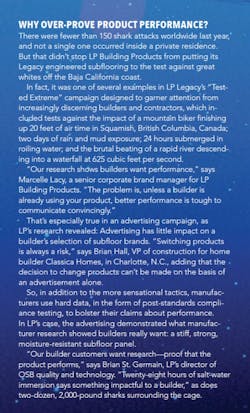When you’re diving in the Pacific Ocean off the coast of Mexico with a respirator in your mouth and goggles on, staring down into a 2,000-foot abyss so deep blue it’s basically black, the first thing you see before the shark reaches you is the white of its belly—and then a mouth so big you can step into it.
I learned that on a trip to test Legacy subflooring for LP Building Products off the coast of Guadalupe Island, famous for its great white sharks. Guided by an experienced adventure film crew, I found myself in a shark cage half built with standard aluminum and steel, the other half with LP’s subflooring. And I lived to tell the tale.
Those are the lengths some manufacturers will go to to assure users about the performance of their building products, but also to grab the attention of builders and contractors.
Why? Because while great white sharks commonly don’t pose a problem in living rooms across America, the building materials selection process is make-or-break for builders, who demand that products be not just effective upon installation, but for the duration of the life of the building.
Of course, home builders have always strived to deliver quality structures, but as their—and their homebuyers’—expectations of what constitutes a safe, healthy, efficient home have evolved, so, too, have construction requirements and the available building product options that deliver on those expected standards of performance.
“Builders are more selective in the materials they use these days, and I think a big reason for that is homeowner expectations,” says Brian St. Germain, director of OSB quality and technology for LP Building Products. “Home quality has increased to such a point that people expect a certain level as ‘standard,’ which wasn’t standard 10 or 20 years ago.”
Knowing which products to use and why has become a valuable and necessary skill for builders—as well as a key message for manufacturers.
Beyond just knowing a product’s price, construction pros must balance a host of other variable factors—quality, affordability, and customer expectations—and that requires a multi-tiered approach. We found several builders, along with some experts on the testing and manufacturing side, who have spent a good bit of time researching and learning the intricacies of product selection and performance, and asked them how they do it.
Building Codes and Climate Zones
It all starts with building codes. Since the earliest U.S. building codes of the late 1800s, how homes are built has evolved tremendously. Requirements for wind loads, glazing, fenestration, and building envelope, for instance, are the product of modern codes and associated state and local regulations.
The current International Building Code, developed by the International Code Council, is in use or has been adopted as the foundation for state-specific codes by all 50 states and the District of Columbia. The International Residential Code for one- and two-family dwellings is also in use in all states—with the exception of Wisconsin. These codes are updated every three years, while new local, state, and federal regulations may be released more frequently.
That dynamic is certainly a challenge for builders and contractors, but also for manufacturers. “The No. 1 reason a manufacturer gets a product tested is to demonstrate code compliance,” says J. Michael Luzier, president and CEO of Home Innovation Research Labs, in Upper Marlboro, Md., an accredited third-party testing lab and certifying body. “There are all kinds of code provisions and standards that require product compliance, and manufacturers need a third party to confirm that compliance.”
For builders, says Luzier, the codes vary—often in subtle ways, and it’s essential for construction pros to keep up with what’s required in their particular area. Builders can ask for help from manufacturers, which should be up to speed and, ideally, be able to interpret the code in a language builders can understand and apply.
“The first thing we look at is how we can be compliant,” says Matthew Waldren, a product engineer in window and door manufacturer Pella’s Design Assurance Lab. “We know what products can be used where. Builders just need to ask us.”
Climate zones play an especially important role in dictating code requirements specific to geography and account for several variances in the building code. Thrive Home Builders, in Denver, an eight-time Grand winner of the Department of Energy’s (DOE) Housing Innovation Awards, is dedicated to energy efficiency and relies on the DOE’s Climate Zone map, not just for code compliance but also to guide it in various performance-certification programs such as Energy Star.
Denver is located in the cooler, drier portion of Climate Zone 5, which snakes across the nation’s midsection, from Northern California to Massachusetts. In that band, fenestration standards in the 2018 International Energy Conservation Code (IECC) demand a U-factor of 0.3 (down from 0.32 in 2015), whereas in Zone 2, further to the southeast in Florida and Texas, the 2018 requirement is 0.40 (unchanged from 2015), and in Zone 1 (the tip of south Florida and in Hawaii) there is no requirement. Typical windows span a U-factor range of U-0.2 to U-1.3. “Using noncompliant materials is a quick way to have a project red-tagged,” Luzier says. “And that can be a killer.”
There are requirements on nearly every portion of a house where performance can be quantified, from the insulating value of walls and ceilings (different for wood versus steel framing) to the solar heat gain coefficient of window glazing, as well as structural and mechanical system installation requirements.
Homes in coastal areas prone to hurricanes, for instance, require higher-rated windows and doors, better connections and flashing for openings, and special flood-resistant solutions, with additional moisture- and decay-resistance for exposed materials. And there are similarly unique requirements for homes in earthquake-, flood-, and wildfire-prone areas.
“Before builders purchase materials,” says Thrive Home Builders CEO Gene Myers, “they need to understand what ‘code compliant’ means in their market.”
Ratings and Standards for Building Products
But “compliant” essentially means achieving minimum requirements, which isn’t a bad thing, but neither is it something to boast about. Third-party ratings, certifications, and standards for individual products and homes, however, go beyond code and can be effective marketing tools.
But most customers aren’t impressed by code compliance because they expect a higher baseline of performance. To impress buyers, market-savvy builders increasingly rely on specialty ratings and standards that afford them the opportunity to claim their homes are better than the baseline. Sometimes far better.
Thrive, for instance, adheres to DOE’s Zero Energy Ready Home program and the Environmental Protection Agency’s Indoor airPLUS program. “OSB, carpet, paint, trim, any of those ... if we see they’re not compliant with the requirements of either of those programs, we stop researching them,” Myers says. “We’re not a run-of-the-mill builder trying to just meet code.”
Both programs, which offer significant online resources to help understand and meet compliance, have strict product requirements to ensure the standard of the healthy buildings they promote, including standards for composite wood products, paints, finishes, sealants, and adhesives—basically anything in a home that could off-gas volatile organic compounds (VOCs).
So-called “green” building standards are a segment that has moved into the mainstream. There are a number of green building rating systems for homes in the U.S. in addition to the DOE Zero Energy Ready Home program: Energy Star for New Homes, National Green Building Standard, LEED, and Passive House certification, among others, as well as many green certification programs for individual products.
“Once we meet our compliance threshold for these programs, our top motivator becomes price,” says Myers, who reviews product costs to protect Thrive’s profit margins. “Our goal is not to create the perfect net-zero energy house. We want to build houses that are healthy but are still reasonably affordable.”
Forging Partnerships With Building Products Manufacturers
Not every product purchase is made with compliance in mind. Some product purchases come about because of partnerships—formal and informal—between builders and manufacturers. “We wouldn’t have reached our energy-efficiency goals had it not been for a manufacturer lending us its resources,” Myers says. “We’ve never signed a partnership agreement [with them], but the arrangement has been worth our loyalty.”
Manufacturers have a strong incentive to partner with builders because, as Aaron Ryan, an evaluation engineer for Pella, puts it, “Builders are key to getting new concepts and feedback on product performance.”
Manufacturers draw from builders like conceptual wells, gleaning insights from the custom solutions they request or desire, some of which end up on the manufacturer’s production lines and supply chain shelves. “Most of LP’s wall assemblies are the result of a builder coming to us and saying, ‘If your product did this, we would buy it,’” St. Germain says.
Builder Tim O’Brien, founder and president of Tim O’Brien Homes, in Milwaukee, relies heavily on manufacturer partnerships. The good news for builders in regard to these arrangements, he says, is that they’re relatively easy relationships to form: “A lot of them come from meeting people at industry events, especially specialized events like the Energy & Environmental Building Alliance [EEBA] Summit. It’s how we started our relationship with DuPont Tyvek.”
In North Carolina, where Classica Homes operates, VP of construction Brian Hall credits these partnerships for the custom solutions they’ve been able to offer clients. “We’ll go to Ultracraft [for cabinets] and say we need this color, with this design flare, at this price point,” he says. “And then they work with us to get there.”
Hall urges builders to find multiple entry points to start these relationships. “Phone, email, trade shows ... dig in with them”—a refrain also often heard from manufacturers.
Starting a collaborative relationship with a manufacturer “can be as simple as giving us a call,” says Ron Greene, national sales manager for manufacturer Broan-NuTone, which is currently seeking to partner with builders committed to energy-efficient homes. “The challenge at trade shows is it’s hard to talk productively. Reaching out through phone or email or visiting us in person tends to be more effective in forging those partnerships.”
Broan, like many manufacturers, offers builders financial incentives for loyalty and using upgraded products, from $5 to $50 per home, Greene says. For large builders, such as D.R. Horton, the low end of that equation would be $235,000, the high end about $2.3 million, assuming a product in every D.R. Horton home. But even a builder closing 100 homes per year could realize up to $5,000.
Now, Let’s Talk About Flair
Then there are products that can withstand a shark attack. “That kind of testing and advertising intrigues us, for sure,” says Classica’s Hall. And that’s exactly the manufacturer’s intent.
“We need to show [builders] more than just exposed subflooring in the rain, that the product maintains peak performance, even in the most extreme conditions,” says Marcelle Lacy, a senior corporate brand manager for LP Building Products.
Great white sharks off Guadalupe Island definitely qualifies as extreme, and more manufacturers are dabbling in such attention-grabbing testing methods.
Pella, for example, used a pitching machine to fire fastballs at windows installed around Chicago’s Wrigley Field to prove the product was “home-run proof,” while Oxx set a 2-ton jeep on four of its jobsite coffee makers to show their strength and toughness. “In tests like that, you never really know what’s going to happen,” Pella’s Ryan says. “The first time you do it, you hope it holds and your lab results will be validated.”
Builders look at such results because they answer questions that general product information and standards compliance aren’t likely to. Still, those results alone probably won’t sway a builder from one product to another, Hall says.
But the materials selection process is never about just one piece of information. Instead, it’s a combination of factors, from code compliance and proven performance to partnerships with manufacturers and more, depending on the circumstances and the product.
“We can’t change materials because a new ad came out,” Hall says. “But if a tried-and-true partner comes to us with a new product and those kinds of test results, we’re much more likely to give it a try and switch if it makes sense.”
James F. McClister is managing editor for Professional Remodeler, a sister publication of Professional Builder.


